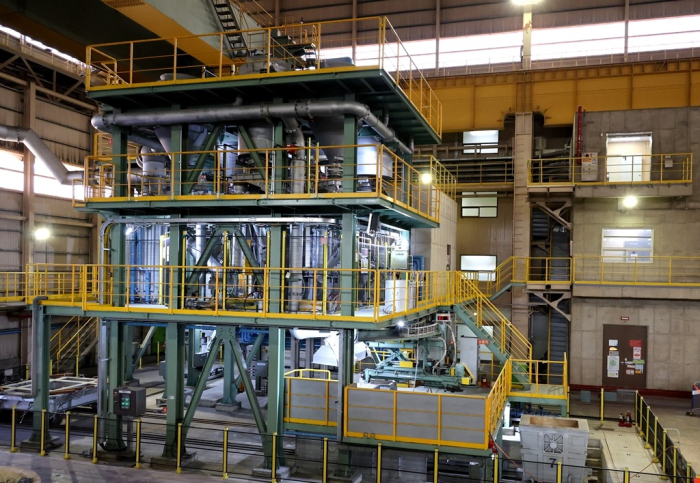Steel
POSCO gears up for carbon-free steelmaking with hydrogen
Production costs, power supply are key issues for POSCO to succeed in the hydrogen reduction steelmaking business
Jun 26, 2024 (Gmt+09:00)
4
Min read
Most Read
Macquarie eyes its 1st Korean data center valued around $722 mn


S.Korea's LS Materials set to boost earnings ahead of IPO process


SK Inc. in talks to sell PharmtecoŌĆÖs US CDMO plant to Novo Nordisk


Galaxy Ring, new foldables set to steal the show at Samsung Unpacked Paris


POSCO gears up for carbon-free steelmaking with hydrogen



POHANG, North Gyeongsang Province ŌĆō POSCO, the worldŌĆÖs seventh-largest steelmaker, is set to significantly reduce emissions in the production process by switching to hydrogen to achieve its goal of carbon neutrality.
POSCO on Monday unveiled a pilot facility, which produces steel using only hydrogen instead of fossil fuel, for the first time. The process, so-called hydrogen reduction (HyREX) steelmaking, can dramatically reduce carbon emissions, according to the POSCO Holdings Inc. unit.┬Ā
The facility, which manufactures up to 24 tons of molten iron a day, emits only 400 kilograms of carbon per ton, much lower than the emissions from the steelmaking process using fossil fuels such as coal and natural gas.
The steelmaking unit of South KoreaŌĆÖs No. 5 conglomerate POSCO Holdings Inc. said the facility will be carbon free once it uses renewable energy.
ŌĆ£The HyREX is expected to become the No. 1 new economic national treasure, which will change 3,000 years of steel history,ŌĆØ said POSCO Senior Vice President Bae Jin-Chan, head of the HyREX project. ŌĆ£Carbon neutrality is not a barrier but an opportunity for the steel sector.ŌĆØ
The industry is a major contributor to carbon dioxide emissions as fossil fuels such as coal and natural gas react chemically with iron ore, generating carbon dioxide. Hydrogen is the only alternative to cut emissions, as it generates only water.
HYREX
POSCO on April 15 succeeded in producing molten iron from the HyREX pilot facility at its Pohang Steel Works. The facility was currently under repair to improve post-process quality and develop additional technologies.
ŌĆ£The analysis of steel initially produced showed the quality of the post-processes, such as the specific gravity of carbon, missed our standards,ŌĆØ said a senior POSCO official. ŌĆ£It is still encouraging that we achieved more than 90% of the original plan, although it is insufficient.ŌĆØ
To produce steel, iron ore needs to go through two processes ŌĆō the reduction reaction to remove oxygen from the ore to make pure iron and then the melting reaction to manufacture molten iron to change shape. In the conventional steelmaking process, a blast furnace, which uses coal, handles both the reduction reaction and the melting reaction, generating massive amounts of carbon dioxide.
Under the HyREX process, the reduction reaction, which uses hydrogen, and the melting reaction occur in a reduction furnace and an electric smelting furnace, respectively, not in a blast furnace. That reduces carbon dioxide emissions. POSCO is the only steelmaker in the world to integrate four reduction furnaces and electric smelting furnaces.

ŌĆ£POSCO significantly cut the production process of hydrogen reduction steelmaking and costs through process innovation,ŌĆØ said Bae. ŌĆ£We are confident that HyREX will become the global standard.ŌĆØ
COSTS, POWER SUPPLY
POSCO plans to break ground on a full-scale hydrogen reduction steelmaking facility with an hourly production capacity of 36 tons in the first quarter of next year with a target completion of 2027 and commercialization by 2030.
The company is poised to increase research staff and engineers for the technology as it aims to produce 2.5 million tons of steel by 2040 and all products only with hydrogen by 2050.
The key issues for the target are costs and power supply.
POSCO said the hydrogen reduction steelmaking costs are more than 30% higher than those of the existing production. No matter how much carbon the company cuts for steel production, few customers will be able to afford such higher costs, industry sources said.
Cutting steelmaking costs requires lower hydrogen production expenses with new technology and renewable energy, POSCO said. The company plans to reduce production costs through process innovation and economy of scale.
Power supply is also a concern. Electricity demand is expected to surge if POSCO operates electric furnaces for hydrogen reduction steelmaking at its steelworks in Pohang and Gwangyang, South Jeolla Province.
POSCO plans to discuss with the government how to reflect such power demand into the countryŌĆÖs electricity supply plan since it is difficult for an individual company to solve the issue by itself.
ŌĆ£The government needs to actively support the private sector on carbon emission issues since it is not a single company problem but a global trade issue,ŌĆØ said an industry source.
By Sang Hoon Sung
uphoon@hanhyung.com
┬Ā
Jongwoo Cheon edited this article.
More to Read
-

-

-
 SteelPOSCO, JSW discuss eco-friendly reduction steel production
SteelPOSCO, JSW discuss eco-friendly reduction steel productionMay 23, 2023 (Gmt+09:00)
1 Min read -
 Hydrogen economyPOSCO to transfer hydrogen steel tech to industry peers for shared growth
Hydrogen economyPOSCO to transfer hydrogen steel tech to industry peers for shared growthOct 07, 2021 (Gmt+09:00)
2 Min read
Comment 0
LOG IN


